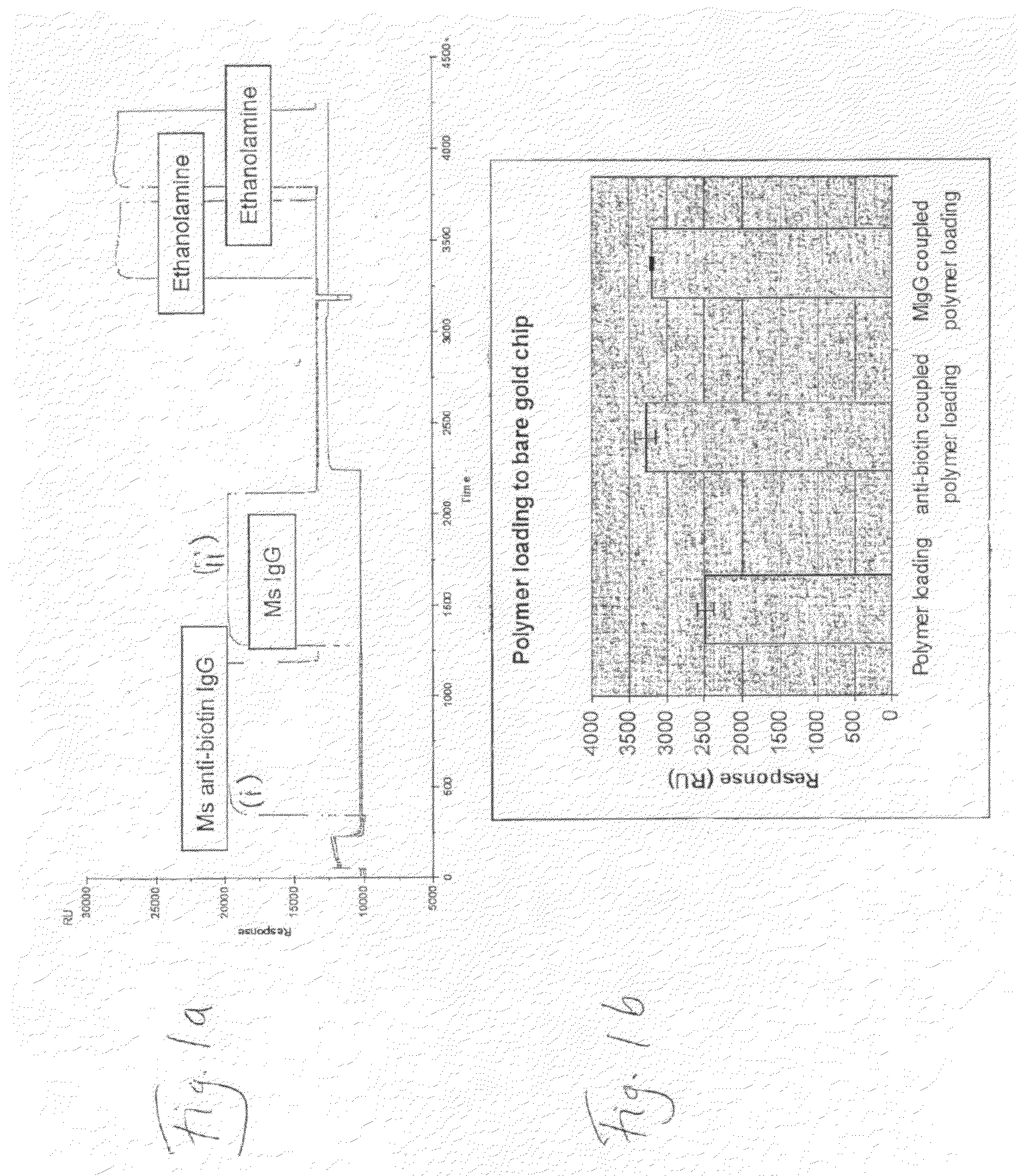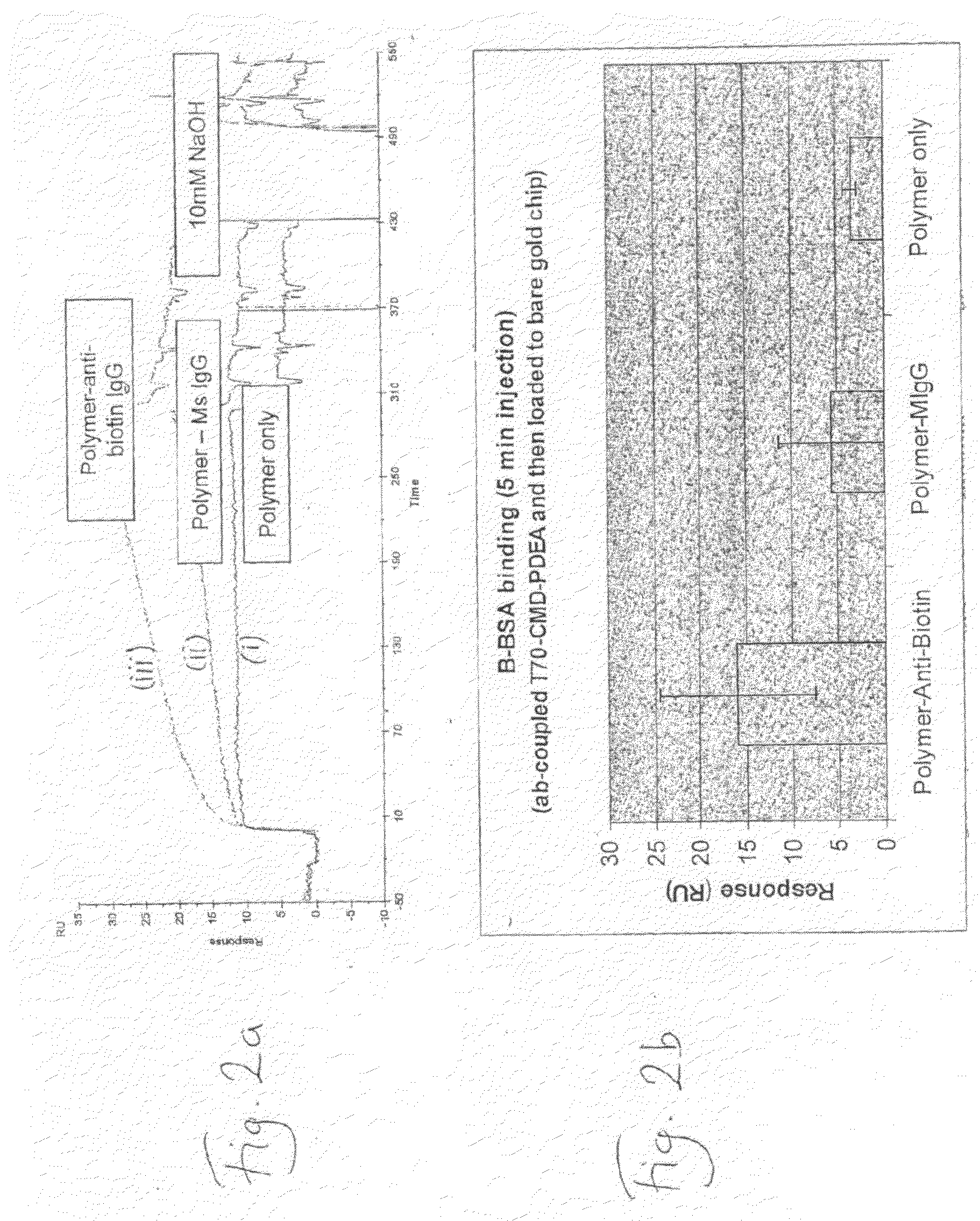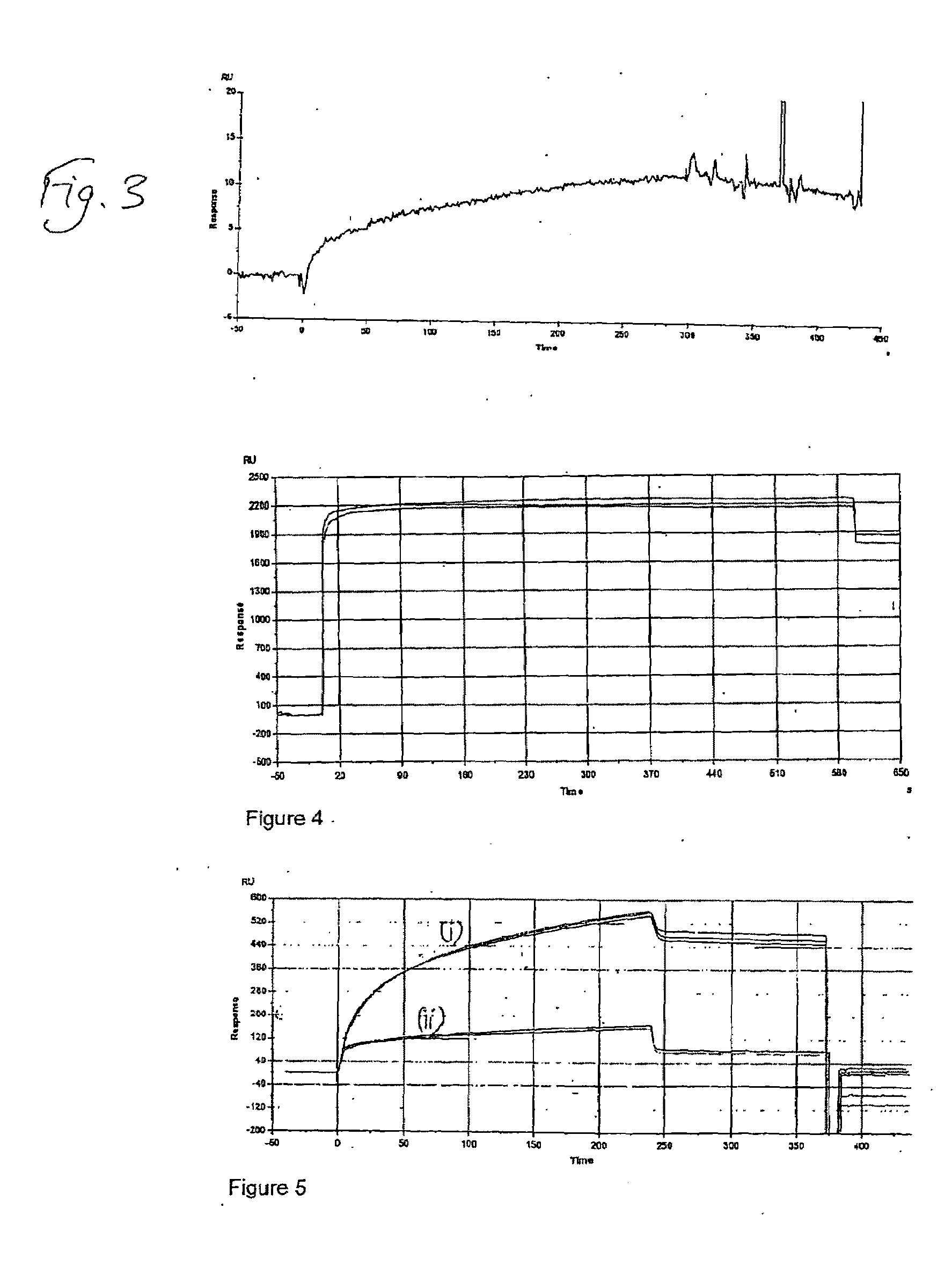Coating Surfaces
- Summary
- Abstract
- Description
- Claims
- Application Information
AI Technical Summary
Benefits of technology
Problems solved by technology
Method used
Image
Examples
example 1
Materials
[0106]1. Akubio Ti / Au chip (Lot. no. 2805) (Material AF 45 (9.82×11.89 mm), 0.30 mm thick from Glass Perfection, Camb. UK (Corning No. 2 glass, clean and scratch free). Metal coating: 1.5 nm Ti+47 nm Au e-beam vapour deposited.[0107]2. Biacore 2000 SPR system[0108]3. Degassed PBS[0109]4. Milli Q water[0110]5. 1% TritonX-100 / 100 mM NaOH solution (0.22 μm filtered)[0111]6. 10 mM NaOAc buffer pH 4.5[0112]7. EDC (400 mM,)[0113]8. NHS (100 mM,)[0114]9. Ethanolamine (1 M, pH 8.5)[0115]10. Mouse monoclonal anti-biotin (Jackson ImmunoResearch Laboratories, Inc. Pennsylvania, USA)[0116]11. Mouse IgG, 2 mg / ml in PBS (Jackson ImmunoResearch)[0117]12. Biotin-BSA, 1 mg / ml in PBS,[0118]13. Dextran-T70-CMD-PDEA
Synthesis of Dextran-COOH-PDEA
Intermediate
[0119]1. Synthesis of (2-(pyridinyldithio)ethaneamine (PDEA)—Used in Step 3 Below.
[0120]Alrithiol-2 (4.41 g, 20 mmol) was dissolved in 20 ml of methanol and 0.8 ml of acetic acid. Into the solution was added 2-aminoethanethiol hydrochloride ...
example 2
Summary of Solution Conjugation of Proteins to Thiosulphone Active Polymer, and Assay Results
Synthesis of Dextran (T70) Thiosulphone
1. Intermediate
4-Nitrophenyl Carbonated Dextran (Used in Step 4 Below).
[0129]To a solution of dextran T70 (1.6 grams, 29.6 mmol OH) in 18 ml of anhydrous DMSO and 16 ml of anhydrous pyridine, were added 4-nitrophenyl chloroformate (800 mg, 4 mmol) and catalytic amounts of DMAP(N,N-Dimethylamino-4-pyridine) with stirring at 0° C. (external cooling bath). The reaction mixture was stirred at this temperature for 1 hour, then at room temperature for a further hour. The solution was slowly added into a mixture of methanol and ether (1:1) (150 ml) with vigorous stirring. The precipitates formed were collected with filtration, and washed with the same solvent mixture 3 times. The collected white solid was dried under high vacuum to give 1.54 grams of white powder.
2. Sodium Methanethiosulfonate
[0130]A mixture of sodium methanesulfonate (1 gram, 9.8 mmol) and su...
example 3
Deposition of T70CMD-PDEA-antibiotin and T70CMD-PDEA-Mouse IgG onto SPR Bare Sold in Flow Mode, and on Binding of Biotin and Biotinylated BSA to the Resulting Surfaces
Equipment
[0148]1) Biacore 2000 SPR system;[0149]2) Akubio Ti / Au chip (Material AF 45, 9.82×11.89 mm, 0.30 mm thick from Glass Perfection, Camb. UK). Metal coating: 1.5 nm Ti+47 nm Au e-beam vapour deposited.
Reagents
[0150]1) Au—SPR chips were used;[0151]2) Biacore SPR 2000.[0152]3) 0.5% SDS, 0.22 μm filtered (for Desorbing step 2)[0153]4) 50 mM glycine, pH 9.5, 0.22 μm filtered (for Desorbing step 3)[0154]5) MilliQ water, 0.22 μm filtered, degassed[0155]6) Running buffer:[0156]a. PBS, 0.22 μm-filtered & degassed[0157]7) Coupling buffer for mouse anti-biotin and mouse IgG:[0158]a. 10% PBS diluted just before use[0159]b. 100 mM NaOAc buffer, pH4.5[0160]8) Ethanolamine 1M, pH 8.5[0161]9) Mouse anti-Biotin (Jackson ImmunoResearch, 1.2 mg / ml)[0162]a. 833 μl of 1.2 mg / ml stock added to 167 μl of PBS pH7.4, to give 1 mg / ml;[01...
PUM
| Property | Measurement | Unit |
|---|---|---|
| Molecular weight | aaaaa | aaaaa |
| Solution | aaaaa | aaaaa |
Abstract
Description
Claims
Application Information
 Login to View More
Login to View More - R&D
- Intellectual Property
- Life Sciences
- Materials
- Tech Scout
- Unparalleled Data Quality
- Higher Quality Content
- 60% Fewer Hallucinations
Browse by: Latest US Patents, China's latest patents, Technical Efficacy Thesaurus, Application Domain, Technology Topic, Popular Technical Reports.
© 2025 PatSnap. All rights reserved.Legal|Privacy policy|Modern Slavery Act Transparency Statement|Sitemap|About US| Contact US: help@patsnap.com



